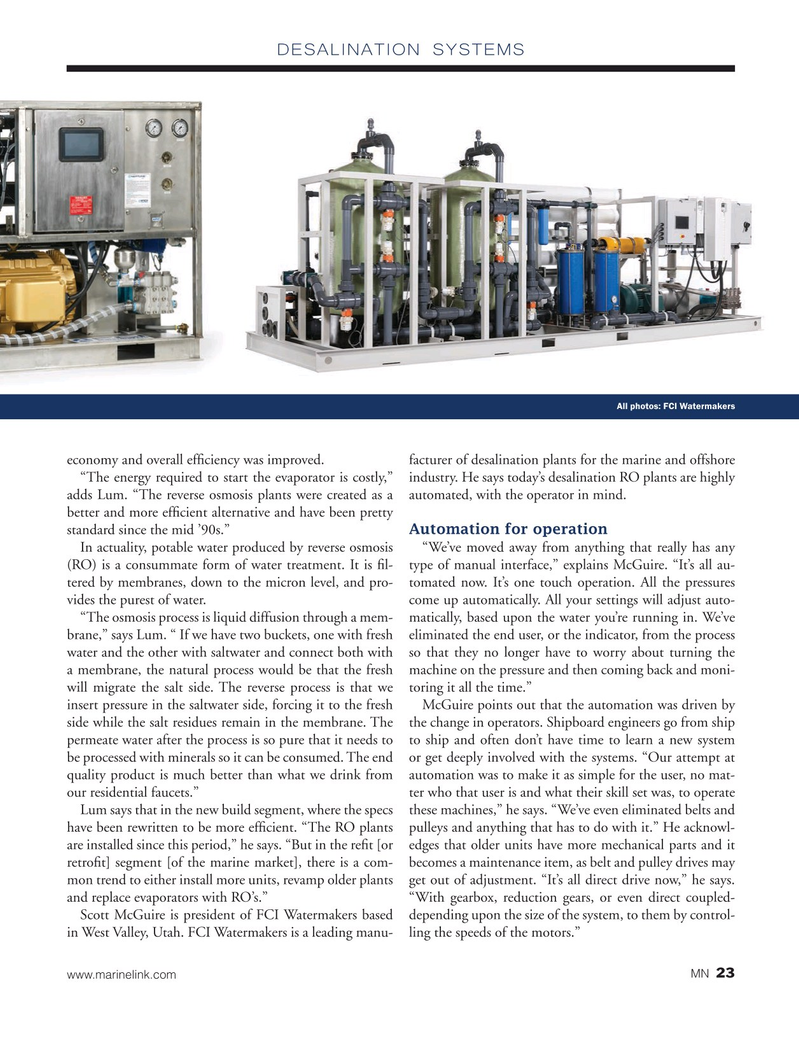
Page 23: of Marine News Magazine (October 2020)
Shipbuilding & Repair
Read this page in Pdf, Flash or Html5 edition of October 2020 Marine News Magazine
DESALINATION SYSTEMS
All photos: FCI Watermakers economy and overall ef? ciency was improved. facturer of desalination plants for the marine and offshore “The energy required to start the evaporator is costly,” industry. He says today’s desalination RO plants are highly adds Lum. “The reverse osmosis plants were created as a automated, with the operator in mind. better and more ef? cient alternative and have been pretty standard since the mid ’90s.” Automation for operation
In actuality, potable water produced by reverse osmosis “We’ve moved away from anything that really has any (RO) is a consummate form of water treatment. It is ? l- type of manual interface,” explains McGuire. “It’s all au- tered by membranes, down to the micron level, and pro- tomated now. It’s one touch operation. All the pressures vides the purest of water. come up automatically. All your settings will adjust auto- “The osmosis process is liquid diffusion through a mem- matically, based upon the water you’re running in. We’ve brane,” says Lum. “ If we have two buckets, one with fresh eliminated the end user, or the indicator, from the process water and the other with saltwater and connect both with so that they no longer have to worry about turning the a membrane, the natural process would be that the fresh machine on the pressure and then coming back and moni- will migrate the salt side. The reverse process is that we toring it all the time.” insert pressure in the saltwater side, forcing it to the fresh McGuire points out that the automation was driven by side while the salt residues remain in the membrane. The the change in operators. Shipboard engineers go from ship permeate water after the process is so pure that it needs to to ship and often don’t have time to learn a new system be processed with minerals so it can be consumed. The end or get deeply involved with the systems. “Our attempt at quality product is much better than what we drink from automation was to make it as simple for the user, no mat- our residential faucets.” ter who that user is and what their skill set was, to operate
Lum says that in the new build segment, where the specs these machines,” he says. “We’ve even eliminated belts and have been rewritten to be more ef? cient. “The RO plants pulleys and anything that has to do with it.” He acknowl- are installed since this period,” he says. “But in the re? t [or edges that older units have more mechanical parts and it retro? t] segment [of the marine market], there is a com- becomes a maintenance item, as belt and pulley drives may mon trend to either install more units, revamp older plants get out of adjustment. “It’s all direct drive now,” he says. and replace evaporators with RO’s.” “With gearbox, reduction gears, or even direct coupled-
Scott McGuire is president of FCI Watermakers based depending upon the size of the system, to them by control- in West Valley, Utah. FCI Watermakers is a leading manu- ling the speeds of the motors.” 23 www.marinelink.com MN

 22
22

 24
24
